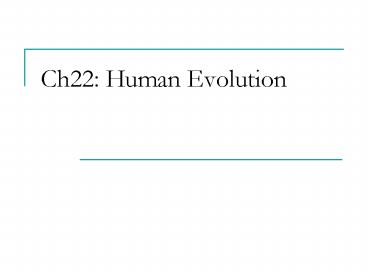Ch22: Human Evolution - PowerPoint PPT Presentation
1 / 18
Title: Ch22: Human Evolution
1
Ch22 Human Evolution
2
Evolution Vs. Intelligent Design
- Evolution
- Change in heritable traits within a population
over successive generations - Supported by scientific evidence
- Intelligent Design
- Concept that certain features of the universe
and of living things are best explained by an
intelligent cause - Can not be supported or rejected by research
3
Geological Time
4
Chemical Evolution
- Atmospheric gases reacted and produces small
organic molecules - Stanley Miller performed an experiment to support
this hypothesis - Small organic molecules joined to produce organic
macromolecules - Organic macromolecules formed the first
Protocell. - Lipid-protein membrane
- Heterotroph takes in preformed food
- Fermenter- created energy without oxygen
- Protocells incorporated RNA ( then DNA) to
create a True cell. - Cell was able to reproduce pass on its genetic
information.
5
(No Transcript)
6
Biological Evolution
- Biological evolution is a change in life forms
between generations. - Two aspects of biological evolution
- Common descent all living descended from a
common ancestor - Explains unity of all living things (i.e. all
living things are made up of cells and have the
same biochemistry) - Adaptation modification in structure, function,
or behavior to better suit the environment - Explains the diversity of life
7
Charles Darwin
- A naturalist that formulated the theory of
evolution based on the following evidence - Biogeographical even though there were suitable
environments for certain plants animals they
were not distributed everywhere. - Anatomical
- Homologous structures anatomical parts that are
similar, but have different functions these
anatomical similarities indicate common descent. - Analogous structures have the same function,
but are anatomically different thus, there is no
common descent - Fossils remains or traces of past life that has
been preserved in the earths crust.
8
Homologous Structures
9
Additional Evidence
- Biochemical Evidence almost all living
organisms use the same basic biochemical
molecules. - DNA genetic information
- Organisms that are closely related have a higher
percentage of similar DNA - Proteins same 20 amino acids
- ATP molecule for energy
10
Evolutionary Mechanisms
- Natural Selection - the process by which a
species becomes adapted to its environment. - Sexual Selection the process by which certain
individuals are chosen to mate. - Genetic Drift random changes in gene frequency
in a population
11
Evolutionary Mechanisms
- Evolutionary Mechanisms are dependent on
- Mutations changes in chromosome structure
- Genetic Recombination changes in alleles
combinations often due to crossing-over - Gene flow movement of alleles of genes into or
out of a population by migration and
interbreeding.
12
Natural Selection
- Variation - physical variations can be passed
from generation to generation - Competition - the environment selects these
better adapted members to have offspring and to
pass on this characteristic - Adaptation - subsequent generation include more
individuals that are adapted in the same way to
the environment.
13
Sexual Selection
- Intrasexual competition same sex individual
fight to mate with females - Intersexual competition females (or males)
choose certain mates based on certain
characteristics.
14
Human Evolution Humans are Primates
- Characteristics of Primates
- Grasping fingers and toes, some with opposable
thumbs - Well-developed brain
- Nails
- Single birth
- Extended period of parental care
- Emphasis on learned behavior
- Two Suborders
- Prosimianslemurs, tarsiers, and lorises.
- Anthropoidsmonkeys, apes, and humans
15
Evolution of Hominids
- Hominid humans Family branch
- Bipedal posture (walking on two feet)
- Flat face
- Brain size
- Australopithecines - a group of individuals that
evolved and diversified in Africa. - Hominids lived about 3 MYA
- Walked erect
- Small brain compared to us, but large brain
compared to other primates - Limb proportions are ape-like
Australopithecus africanus with its large brain
is the best ancestral candidate for early Homo
16
Evolution of Homo
- Homo habilis - may be the ancestor to modern
humans (2.0-1.9 MYA) - Made tools
- Large brain
- Dentition
- Omnivores (plant gatherers and hunters)
- May have had the rudiments of a culture
- Homo erectus may have evolved from Homo habilis
(1.9 -.3 MYA) - Large brain
- Striding gait
- Made well-fashioned tools
- Control of fire
- Migrated into Europe and Asia
17
Evolution of Modern Humans
- Multiregional Continuity Hypothesis evolution
of modern humans was essentially similar in many
different places. - Out-of-Africa Hypothesis evolution of H.sapiens
evolved from H.erectus only in Africa and then
H.sapiens migrated to Europe Asia
18
We are one Species
- Biological definition of a species Any group of
organisms able to interbreed and bear fertile
offspring.































